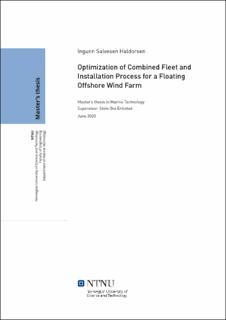| dc.contributor.advisor | Erikstad, Stein Ove | |
| dc.contributor.author | Haldorsen, Ingunn Salvesen | |
| dc.date.accessioned | 2021-09-21T16:35:45Z | |
| dc.date.available | 2021-09-21T16:35:45Z | |
| dc.date.issued | 2020 | |
| dc.identifier | no.ntnu:inspera:54166542:45871762 | |
| dc.identifier.uri | https://hdl.handle.net/11250/2780168 | |
| dc.description.abstract | Det økende behovet for alternative energikilder har resultert i en større interesse for vindkraft. I løpet av de siste årene, har mange vindmølleparker blitt flyttet fra land til lokasjoner til havs. På verdensbasis består 5,56 % av det totale havoverflatearealet av vanndybder under 100 meter. Norskekysten består hovedsakelig av dype vannområder, og har bidratt til at næringen har beveget seg mot flytende offshorekonsepter. Mange flytende havvindprosjekter er foreslått for utbygging, både langs den norske kystlinjen og internasjonalt, for eksempel langs kystlinjene i Japan og USA. Tilknyttet disse planene er søken etter design eller konsepter som minimerer livssykluskostnadene til havvindparker. En kostnadsreduksjon i installasjonen av flytende havvindparker, som ofte utgjør nesten 20 % av livssykluskostnadene, er avgjørende for at næringen kan bli konkurransedyktig mot andre energikilder.
Basert på Hywind Scotland og studier om havvindparker, er åtte viktige installasjonstrinn identifisert. Disse inkluderer transport av komponenter og forankringer, montering, tauing, anker- og kabelinstallasjon, tilkobling og endelig igangsetting. I motsetning til bunnfaste vindparker, foregår hele monteringen av turbinen i havn. Ulike flåtekonsepter har blitt foreslått som løsninger for å utføre installasjonen. I motsetning til installasjon av bunnfaste vindparker, kreves ikke jack-ups eller andre store løftefartøyer. Installasjon av flytende vindparker kan gjøres med mindre fartøyer. Egnede fartøykategorier inkluderer AHTS-skip, slepefartøy, kabelleggingsfartøy og transportfartøy.
Analyser av installasjonsprosessen og dens krav har skapt grunnlaget for utviklingen av en optimaliseringsmodell. Modellen identifiserer den optimale flåten og tidsskjemaet for installasjonen, ved å minimere installasjonskostnadene. Implementering av modellen gjøres i Python, og Gurobi er brukt som optimeringsprogram. Et eksempel, basert på gjennomføringen av Hywind Scotland, brukes til å analysere installasjonskostnadene, optimal flåte og tidsskjema for installasjon. Resultatene viser at mobiliseringskostnader, dagrater, drivstoffkostnader og utførelsestider er betydelige bidragsytere på den totale kostnaden. Installasjonen av én flytende turbin er beregnet å ta 28 dager, mens fem turbiner kan installeres på 82 dager. Én turbin har en anslått installasjonskostnad på 533 000 £, mens en vindpark bestående av femten turbiner gir en installasjonskostnad per turbin på 469 000 £. Dette innebærer en kostnadsreduksjon på 12 %, kun knyttet til leie av flåten. Forutsatt at turbinene blir installert suksessivt, holder størrelsen på flåten seg konstant for vindparker større enn tre turbiner.
I dette arbeidet er det utviklet en modell for optimalisering av kombinert flåtevalg og installasjonsplan. Dette er gjort for å gi en kostnadseffektiv installasjon og for å lage et beslutningsverktøy nyttig for fremtidige flytende offshore vindprosjekter. | |
| dc.description.abstract | The rising need of alternative energy sources has resulted in an increasing interest in wind energy. In recent years, wind farm locations have shifted from land-based sites towards offshore solutions. Shallow waters, defined as depth zones below 100 m, comprise only 5.56% of the total sea surface area. This small share has triggered the industry towards floating offshore concepts. Numerous floating offshore wind sites have been suggested for development, both along the Norwegian coastline and internationally, for example at the shorelines of Japan and the US. Associated with these plans, is the search for designs or concepts minimizing the life cycle costs of the offshore wind farms. A cost reduction in the installation of the floating offshore wind farm, which may account for almost 20% of the life cycle costs, is crucial in order to be cost-competitive to other sources of energy.
Based on Hywind Scotland and studies on offshore wind installations, eight major installation steps have been identified. These include transportation of components and anchors, assembly in port, tow-out, anchor and cable installation, hook-up and final commissioning. In contrast to bottom fixed wind farms, the entire assembly takes place in port. Different fleet concepts have been proposed as solutions for the installation execution. The installation of floating turbines does not require big jack-ups or other heavy lift vessels, and smaller vessels are sufficient for the operations. The suitable vessel categories capable of completing the operations, include AHTS vessels, tugs, cable laying vessels and transportation vessels.
The analysis of the installation process and its requirements are fundamental for the development of a continuous optimization model. This model identifies the optimal fleet and schedule, thus minimizing the installation costs. Implementation of the model is done in Python, using Gurobi as an optimization tool. A case example, similar to the Hywind Scotland project, is used to analyze the installation costs, optimal fleet and installation schedule. It is found that mobilization costs, day rates, fuel costs and execution times are significant cost contributors. The installation of one floating turbine is estimated to take 28 days, while five turbines can be installed in 82 days. Furthermore, increasing the farm size provides major cost reductions. One turbine has an estimated installation cost of 533,000 £, while a farm consisting of fifteen turbines incurs an installation cost per turbine of 469,000 £. This implies a cost reduction of 12%, only considering the costs associated with the charter of the fleet. Assuming a strategy installing the turbines successively, the fleet is found to be constant for farm sizes exceeding three turbines. For a case example located at the shore of Norway, results show that a fleet of five vessels is sufficient for successful installation.
In this work, a model for optimization of the combined fleet selection and installation schedule has been developed. This has been done to provide a cost-effective installation and to provide a decision tool for future floating offshore wind projects. | |
| dc.language | | |
| dc.publisher | NTNU | |
| dc.title | Optimization of Combined Fleet and Installation Process for a Floating Offshore Wind Farm | |
| dc.type | Master thesis | |
